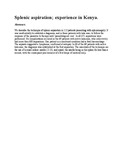| dc.description.abstract | We describe the technique of splenic aspiration in 113 patients presenting with splenomegaly. It was used initially to establish a diagnosis, and in those patients with kala azar, to follow the response of the parasites to therapy until 'parasitological cure'. In all 671 aspirations were performed. No complications occurred in the 69 patients with active kala azar, who collectively had more than 600 aspirations. One patient in a moribund condition had a fatal haemorrhage. The aspirate suggested a lymphoma, confirmed at autopsy. In 68 of the 69 patients with active kala azar, the diagnosis was established at the first aspiration. The essentials of the technique are the use of a small calibre needle (21 G), and speed, the needle being in the spleen for less than a second, with the consequent procurement of a few drops of material only. | en |

